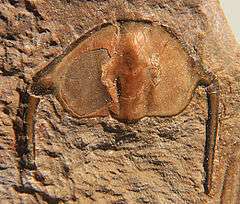Biceratopsinae
The Biceratopsinae is an extinct subfamily of redlichiid trilobites within the family Biceratopsidae, with species of small to average size. Species belonging to this subfamily lived during the Toyonian stage (Upper Olenellus-zone), 516-513 million years ago, in the former continent of Laurentia, including what are today the South-Western United States and Canada.[4]
| Biceratopsinae | |
|---|---|
 | |
| Emigrantia sp., a cephalon | |
| Scientific classification | |
| Kingdom: | |
| Phylum: | |
| Class: | |
| Order: | |
| Suborder: | |
| Superfamily: | |
| Family: | |
| Subfamily: | Biceratopsinae (Pack & Gayle, 1971)[1] |
| Genera | |
| |
Etymology
The Biceratopsinae are named for the type species Biceratops nevadensis.
Habitat
The Biceratopsinae were probably marine bottom dweller, like all Olenellina.
gollark: I have never found petramor to actually work well.
gollark: It might run on things with fewer than a terabyte of RAM and 6 cores, which is good.
gollark: Or just forgot to. I hope.
gollark: I know, who thought that was a good idea?!
gollark: There seems to be one, and only one, industrial mod with power and stuff, called Technic.
References
- Lieberman, B.S. (1999). "Systematic Revision of the Olenelloidea (Trilobita, Cambrian)" (PDF). Bulletin of the Peabody Museum of Natural History. 45.
- M., Webster (2007). "Ontogeny and evolution of the early Cambrian trilobite genus Nephrolenellus (Olenelloidea)". Journal of Paleontology. 81: 1168–1193. doi:10.1666/06-092.1.
- Webster, M. (2007). "Paranephrolenellus, a New Genus of Early Cambrian Olenelloid Trilobite". Memoirs of the Association of Australasian Palaeontologists. 34: 101–130.
- Pack, P.D.; Gayle, H.B. (2009). "A New Olenellid Trilobite, Biceratops nevadensis, from the Lower Cambrian near Las Vegas, Nevada". Journal of Paleontology. 45 (5). pp. 893–898.
This article is issued from Wikipedia. The text is licensed under Creative Commons - Attribution - Sharealike. Additional terms may apply for the media files.